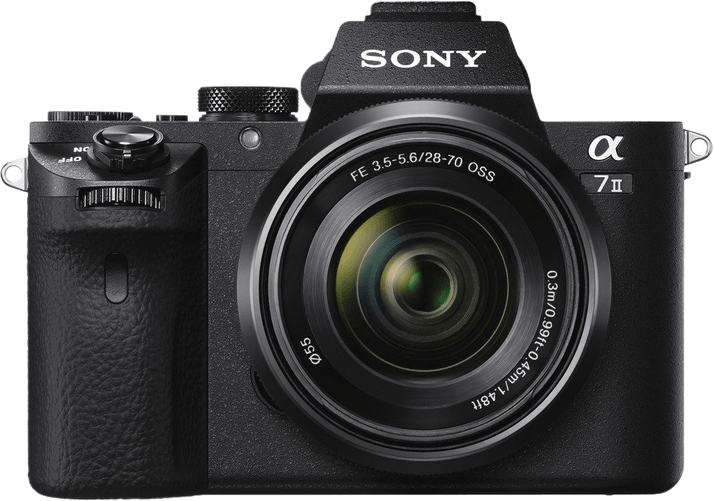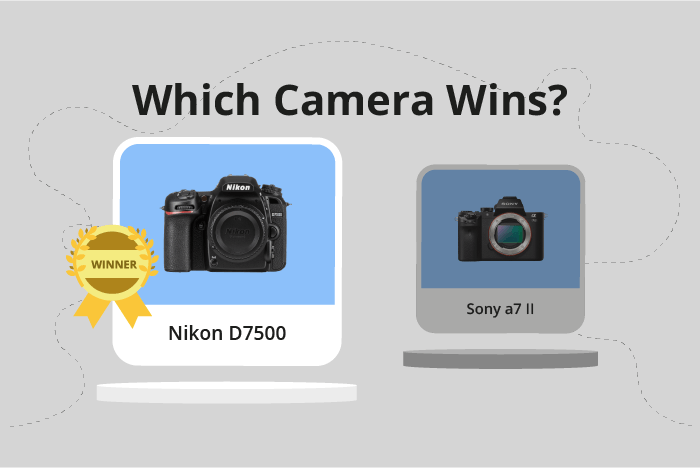Nikon D7500 vs Sony a7 II Comparison
Nikon D7500

Sony a7 II

The Nikon D7500 takes the lead with a score of 70/100, while the Sony a7 II trails closely with 69/100. Both cameras share similarities, such as announcement dates in the 2010s and being part of the DSLR and mirrorless categories, respectively.
The Nikon D7500 outperforms the Sony a7 II with its larger size, measuring 136 x 104 x 73mm and weighing 1.59lbs. Its launch price is also more affordable, at $1250 compared to the Sony a7 II’s $1600.
On the other hand, the Sony a7 II offers a more compact design, measuring 127 x 96 x 60mm and weighing 1.32lbs. This makes it more convenient for users who prioritize portability.
Taking these factors into account, the Nikon D7500 offers better value for its price and performance, while the Sony a7 II provides a more compact option for those who prioritize size and weight.
Nikon D7500 vs Sony a7 II Overview and Optics
The Sony a7 II wins in the optics comparison with a score of 78/100, while the Nikon D7500 scores 68/100. Both cameras share common specifications such as the CMOS sensor type and the ability to shoot at high speeds. However, there are significant differences between the two cameras that contribute to the Sony a7 II’s higher score.
The Sony a7 II has 24.2 megapixels, which is higher than the Nikon D7500’s 20.9 megapixels. This results in better image quality and detail capture. Additionally, the Sony a7 II has a full-frame sensor, while the Nikon D7500 has an APS-C sensor. Full-frame sensors provide better image quality and low light performance. The Sony a7 II’s sensor also has a higher DXOMARK score of 90 compared to the Nikon D7500’s 86, indicating better overall sensor performance.
Another advantage of the Sony a7 II is its built-in image stabilization, which the Nikon D7500 lacks. This feature helps reduce camera shake and improve image sharpness, especially in low light conditions or when using longer focal length lenses.
Despite these advantages, the Nikon D7500 does have a faster shooting speed of 8 frames per second, compared to the Sony a7 II’s 5 frames per second. This makes the Nikon D7500 more suitable for action photography and capturing fast-moving subjects.
To conclude, the Sony a7 II offers superior optics with its higher megapixel count, full-frame sensor, and built-in image stabilization. However, the Nikon D7500 may be more suitable for those who prioritize faster shooting speeds for action photography.
Nikon D7500 vs Sony a7 II Video Performance
The Nikon D7500 outperforms the Sony a7 II in video capabilities, earning a score of 70 out of 100 compared to the Sony a7 II’s score of 56. Both cameras share certain video features, such as the ability to record video in an MP4 format and offering manual control over exposure settings.
The Nikon D7500 excels in several aspects. It offers a maximum video resolution of 4K (3840 x 2160), which is significantly higher than the Sony a7 II’s Full HD (1920 x 1080) resolution. The higher resolution allows the Nikon D7500 to capture more detail and produce sharper videos. Additionally, the Nikon D7500 has a built-in time-lapse functionality, which is absent in the Sony a7 II. This feature enables users to create time-lapse videos without the need for additional software or equipment.
On the other hand, the Sony a7 II has a higher maximum video frame rate of 60fps, compared to the Nikon D7500’s 30fps. This higher frame rate can be beneficial for capturing fast-moving subjects and producing smoother slow-motion footage. However, the lower video resolution of the Sony a7 II limits the overall video quality.
In comparing the video capabilities of the Nikon D7500 and the Sony a7 II, it is evident that the Nikon D7500 is superior due to its higher video resolution and built-in time-lapse functionality. While the Sony a7 II does offer a higher maximum video frame rate, the advantage is not enough to outweigh the benefits provided by the Nikon D7500. Therefore, the Nikon D7500 is the better choice for those prioritizing video performance in their camera selection.
Nikon D7500 vs Sony a7 II Features and Benefits
The Nikon D7500 triumphs over the Sony a7 II in features, boasting a score of 83/100 compared to the Sony’s 57/100. Both cameras share certain specifications, including a flip screen, lack of GPS, and WIFI connectivity. However, the Nikon D7500 outshines the Sony a7 II with its superior features, while the Sony a7 II has some advantages of its own.
The Nikon D7500 has a larger screen size of 3.2 inches compared to the Sony a7 II’s 3 inches. The D7500 also features a touchscreen, allowing for easier navigation and control. Additionally, the Nikon D7500 includes Bluetooth connectivity, further enhancing its wireless capabilities. These aspects contribute to the Nikon D7500’s higher feature score.
On the other hand, the Sony a7 II has a higher screen resolution at 1230000 dots, compared to the Nikon D7500’s 922000 dots. This results in a sharper and clearer display on the Sony a7 II. However, it lacks a touchscreen and Bluetooth connectivity, which are significant disadvantages compared to the Nikon D7500.
In examining the features of both cameras, the Nikon D7500 is the clear winner due to its larger touchscreen, Bluetooth connectivity, and overall higher feature score. The Sony a7 II, while having a higher screen resolution, falls short in other areas, making it the less appealing option. Thus, the Nikon D7500 is the better choice for those seeking a camera with more advanced features and greater ease of use.
Nikon D7500 vs Sony a7 II Storage and Battery
The Nikon D7500 triumphs over the Sony a7 II in storage and battery with a score of 43/100 compared to Sony’s 35/100. Both cameras possess a single memory card slot and accept SD, SDHC, and SDXC cards. However, the Sony a7 II also supports Memory Stick Duo, Pro Duo, and Pro-HG Duo cards, offering more storage options.
The Nikon D7500 excels in battery life, providing 950 shots per charge, significantly outlasting the Sony a7 II’s 350 shots. This substantial difference in battery life makes the Nikon D7500 a more reliable option for extended shooting sessions. Both cameras use different battery types, with the Nikon D7500 utilizing the EN-EL15a and the Sony a7 II using the NP-FW50.
Despite the Sony a7 II’s additional memory card compatibility, the Nikon D7500’s superior battery life makes it the clear winner in the storage and battery category.
Nikon D7500 vs Sony a7 II – Our Verdict
Are you still undecided about which camera is right for you? Have a look at these popular comparisons that feature the Nikon D7500 or the Sony a7 II:

